 A quarterly magazine of the IMF | March 2008, Volume 45, Number 1 |
Riding a Wave
Thomas Helbling, Valerie Mercer-Blackman, and Kevin Cheng
Soaring commodity prices may have a lasting impact
Commodity markets have been booming. Prices of many commodities—especially those of oil, nickel, tin, corn, and wheat—have reached record highs in recent months despite credit market turbulence and slowing activity in many major advanced economies (see Chart 1). The current boom has also been more broad based and longer lasting than is usual, and it contrasts noticeably with the 1980s and 1990s, when most commodity prices were on a downward trend. That said, despite the apparent reversal of the downward trend, inflation-adjusted prices of many commodities are still well below the levels seen in the 1960s and 1970s.
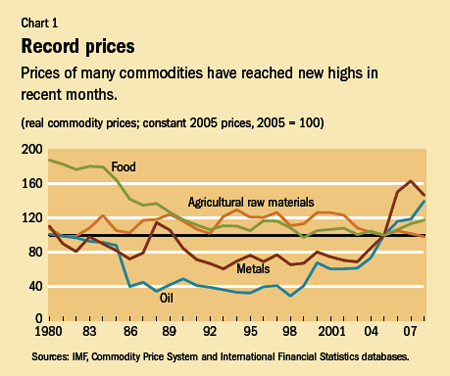
The price boom has brought a sea change to the commodities landscape. Commodity- exporting countries have benefited from rapidly growing export revenue. In fact, a number of analysts see high commodity prices as an important reason for the buoyant growth in many emerging and developing economies. At the same time, investment in the commodities sector has accelerated after a long period of lackluster performance. And, in financial markets, commodities are now an established part of the wider class of alternative assets. At the same time, commodity importers and consumers have begun to feel the pinch from higher commodity prices, with widespread concern about the impact on the poor in emerging and developing economies.
Although buoyant global growth in recent years is only one of the reasons for high prices, forecasts of slower global activity in 2008–09 have prompted concerns about prospects for commodity markets. Against this backdrop, the IMF recently undertook a study to better understand what is behind the commodities boom and its likely macroeconomic impact around the globe. It found that the current commodities boom reflects many cyclical and structural factors. It also found that, although the impact of this largely demand-driven boom on the global economy has been limited so far, higher commodity prices have begun to pose inflation risks and may lead to external financing challenges for some countries, particularly low-income net commodity importers.
Demand and supply factors
Why are commodity prices so high? Besides commodity-specific factors—such as geopolitical risks, weather conditions, and crop infestations—the current price boom is driven by demand and supply forces that reinforce each other amid supportive financial conditions.
First, emerging economies have driven demand for various commodities—a trend that is likely to continue. Annual increases in the global consumption of major commodity groups during 2001–07 were larger than they had been during the 1980s and 1990s (see Chart 2). And although buoyant global growth was a key contributor, it was reinforced by a combination of strong per capita income growth, rapid industrialization, higher commodity intensity of growth, and rapid population growth in some major emerging economies (notably China, India, and in the Middle East). All of these factors have contributed to the rapid pace at which demand has grown in recent years.
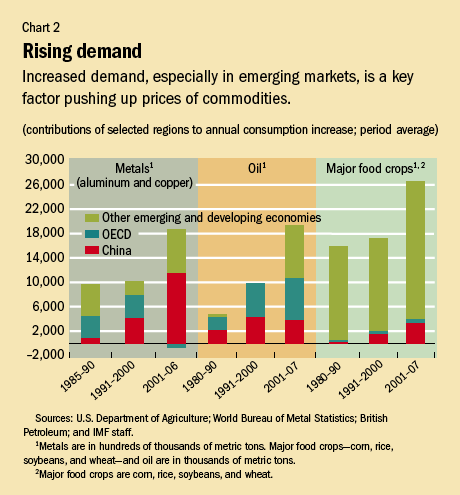
In the oil market, demand from China, India, and the Middle East accounted for more than 56 percent of the growth in oil consumption during 2001–07. This growth was driven partly by the increasing vehicle ownership associated with higher per capita incomes. Passenger car sales in China, for example, increased more than fivefold during 2001–07 (see "Picture This" in this issue). At the same time, industrialization and urbanization in emerging markets, particularly in China, have boosted demand for fuel-based electricity. As a result, prices of other fuels—particularly coal, which is crucial for power generation—have also rapidly gone up in recent months.
In some instances, soaring fuel demand in certain emerging economies has also reflected policy factors, particularly domestic end-user prices that are delinked from world market prices and thus increasingly subsidized, especially in oil-exporting economies. And the International Energy Agency has projected that oil consumption growth in emerging and developing economies would continue to outstrip such growth in advanced economies—increasing by about 3½ percent a year during 2007–12, compared with the latter's 1 percent.
Emerging economies are also playing a key role in the boom in nonfuel commodity markets. In particular, China's industrialization and urbanization have galvanized consumption of base metals. During 2000–06, for example, China alone accounted for about 90 percent of the increase in the world consumption of copper, which is indispensable for construction. Also, as emerging economies become more affluent, they are not only consuming more food but shifting their diet toward high-protein foods such as meat, seafood, edible oils, and fruits and vegetables. In 2006, China accounted for one-fifth of global consumption of wheat, corn, rice, and soybeans. In fact, China is now the world's largest importer of soybeans in the world, consuming about 40 percent of the world's soybean exports.
Second, biofuels have boosted the demand for specific food crops. Another prominent factor underpinning the difference between this boom and earlier ones is the role of biofuels. High oil prices in recent years, together with generous policy support in the United States and the European Union, have led to a surge in the use of biofuels as a supplement to transportation fuels, particularly in the advanced economies. In 2005, the United States overtook Brazil as the world's largest producer of ethanol, which accounts for over 80 percent of global biofuel use. The European Union is the largest biodiesel producer.
Biofuel production is seriously affecting food markets—20–50 percent of feedstocks, especially corn and rapeseed, in major producing countries are being diverted from food to biofuels—but not affecting petroleum product markets, in which biofuels constitute less than 1½ percent of transportation fuel supply. This is creating a price asymmetry—which means that the prices of petroleum products are determining retail prices of biofuels, and growth of biofuels, in turn, is strongly affecting feedstock prices (ethanol, in particular, is produced from corn and sugar).
Ambitious mandates about biofuel use in the United States and the European Union imply that diverting crops toward biofuel production will continue for at least another five years, when new technology in the form of second-generation biofuel feedstocks—made of inedible vegetable matter that does not compete for the land and the water resources used for major food crops—become commercially viable. In the United States, the 2007 Energy Bill almost quintuples the biofuels target, to 35 billion gallons by 2022, and the European Union has mandated that 10 percent of transportation fuels must use biofuels by 2020. This means that upward pressures on prices of some of the major food crops will continue for some time.
Third, slow supply responses have amplified price pressures. Increased demand alone cannot explain the large and persistent rise in commodity prices seen in recent years. Supply factors also play a role. The slow supply response in the initial phases of this primarily demand-driven boom did not come as a surprise, given limits to production increases in the short term. Excess demand is accommodated by inventory drawdowns while prices increase—a pattern that was seen in many commodity markets in recent years. Because the demand for commodities tends to be price inelastic—that is, a large change in the prices of commodities leads to only a small change in the demand for them, especially in the short term—the feedback effects of rapid price increases on demand during these phases tend to be limited, which partly explains the large spikes often seen in commodity markets.
Besides initial supply-response problems, however, a new key feature that has emerged in the current broad-based commodity market boom is the increasingly prominent role of the slow supply adjustment to increased demand. Such structural problems have been particularly acute in the case of oil, where capacity growth in response to persistently higher prices has been disappointing in recent years (see Chart 3). And, as the pessimistic prospects for capacity growth have seemed more certain, these expectations have further fueled price pressures. This was particularly the case in 2007. Key handicaps have been the declining average size of fields and the technological challenges involved in the increasing reliance on exploiting nonconventional fields (for example, deep sea fields or oil sands). These supply rigidities, together with soaring demand for oil equipment and services, have pushed up costs dramatically. As a result, despite a 70 percent increase in nominal investment during 2004–06, real investment in the upstream sector has barely grown. Although some of the cost increases related to the high demand for inputs are cyclical and should subside once oil equipment and skilled labor supply catch up, those related to geological and technological problems are likely to persist for some time.
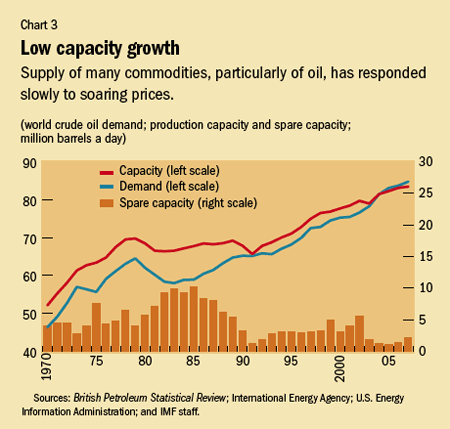
Over time, market balances have tightened for other commodities as well. Inventories of many commodities have dropped to very low levels despite robust production growth, given soaring demand. For example, commercial oil inventories in advanced economies fell sharply in 2007, inventories of major base metals have all reached critical lows over the past two years, and stocks of major food crops (including wheat and corn) are at a two-decade low (see Chart 4). In such an environment, prices tend to be highly sensitive to news signaling possible supply shortages.
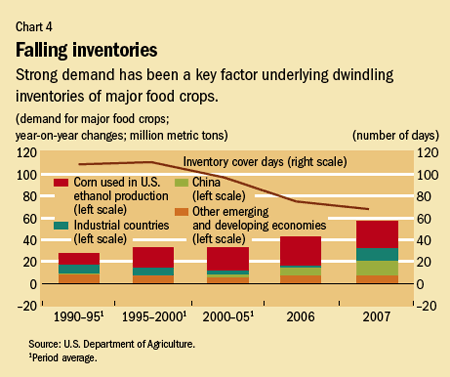
Fourth, important linkages across commodities transmit higher prices. Linkages across the markets for various commodities beyond those related to common macroeconomic conditions have also played a role in recent price increases. For example, demand for biofuels has propelled not only prices of corn but also those of other food products, because corn is used as input in their production (meat, poultry, dairy) or as a close substitute. In the United States, for example, it has exerted significant upward pressure on prices of soybean meal and soybean oil (because corn and soybeans compete for the same acreage), which has contributed to the price increases of other edible oils through substitution effects. To a lesser extent, demand for biodiesel has also affected prices of edible oils, because soybean oil and other vegetable oils such as palm oil and rapeseed oil are used as biodiesel inputs.
Higher oil prices have also had an important effect on other commodities, not only through the traditional cost-push mechanism (because oil is used as an input in agriculture and the production of metals such as aluminum) but also through substitution effects. For example, natural rubber prices have risen because its substitute is petroleum-based synthetic rubber. Uranium price increases have been driven by demand for nuclear energy, whereas coal prices have recently risen because of utilities' switching from more expensive fuel oil to coal for power generation. And, of course, biofuels are substitutes for gasoline and diesel at the margin.
Fifth, low interest rates and effective dollar depreciation have been a supporting factor. With the rapid expansion of commodity financial markets in recent years, many commodity prices are more directly exposed to various macrofinancial shocks. The main reason is that spot prices of a growing number of commodities are determined in exchange-based trading. Although such trading has long existed for some agricultural commodities such as grains, it has recently become more prevalent for other commodities. For example, oil prices were determined primarily by long-term contracts between oil producers and oil companies until the late 1970s, but they are now determined primarily in futures markets, in which supply and demand forces determine both spot prices and prices for future delivery (futures prices). Moreover, with many futures contracts settled in cash rather than through the delivery of the underlying commodity, investors outside the commodity business can now use commodities to diversify their portfolio, thereby more closely linking futures markets for commodities with other financial markets. This has opened up new opportunities for market participants but also led to challenges (see box).
Besides their close link with global economic growth discussed earlier, commodity prices have also been supported by other macrofinancial conditions, especially low interest rates and the depreciating effective U.S. dollar exchange rate. Low interest rates can spur aggregate demand, which would increase the demand for commodities. Besides this growth-related effect, the favorable liquidity conditions associated with low interest rates also tend to increase both asset demand for commodities (partly because low-yielding treasury bills are less attractive) and incentives for holding commodity inventories by lowering holding costs, everything else being equal.
The U.S. dollar exchange rate affects commodity prices because most commodities—in particular, crude oil, precious metals, industrial metals, and grains such as wheat and corn—are priced in U.S. dollars. The effective dollar depreciation seen over the past few years therefore has made commodities less expensive for consumers outside the dollar area, thereby increasing the demand for the commodities. On the supply side, the declining profits in local currency for producers outside the dollar area have put price pressures on the commodities. A decline in the effective value of the dollar also reduces the returns on dollar-denominated financial assets in foreign currencies, which can make commodities a more attractive class of "alternative assets" to foreign investors (see box). Finally, dollar depreciation can lead to monetary policy easing and lower interest rates in other economies, especially in countries whose currencies are pegged to the dollar, which also raises the demand for commodities, as discussed above.
Commodities-related financial markets have expanded rapidly and gained importance in recent years. For example, the open futures positions—defined as a specific commodity's number of open futures and options contracts outstanding at the end of the trading Commodities as alternative financial assets day, whether for purchase or sale—of crude oil traded on the New york mercantile Exchange have grown threefold since 1995. trade in over-the-counter derivative instruments has also expanded, and limited data suggest it may be many times larger than trade in organized exchanges, particularly for crude oil. The expansion of commodity financial markets creates new opportunities as well as challenges. on the one hand, financial markets can enhance the liquidity, depth, and fluidity of commodity trades, which helps price discovery—a function that is more effectively performed within an exchange setting. Commodity financial markets also contribute to the efficient allocation of risk. Financial hedging, as a form of insurance, can be used by commodity market participants to reduce risks associated with excessive commodity price volatility that complicate budgetary, financial, and investment plans. On the other hand, the simultaneous increase in prices and in investor interest, especially by speculators and index traders, in commodity futures markets in recent years can potentially magnify the impact of supply-demand imbalances on prices. Some have argued that high investor activity has increased price volatility and pushed prices above levels justified by fundamentals, thus increasing the potential for instability in the commodity and energy markets. What does the empirical evidence suggest? A formal assessment is hampered by data and methodological problems, including the difficulty of identifying speculative and hedging-related trades. despite such problems, however, a number of recent studies seem to suggest that speculation has not systematically contributed to higher commodity prices or increased price volatility. For example, recent imF staff analysis (September 2006 World Economic Outlook, Box 5.1) shows that speculative activity tends to respond to price movements (rather than the other way around), suggesting that the causality runs from prices to changes in speculative positions. in addition, the Commodity Futures trading Commission has argued that speculation may have reduced price volatility by increasing market liquidity, which allowed market participants to adjust their portfolios, thereby encouraging entry by new participants. Finally, although many transactions are described as speculative, they may in fact reflect a precautionary desire to hedge exposures in the face of uncertainty. For example, concerns about future shortages—particularly oil—could lead to a genuine desire by consumers to hold increased inventories, thereby pushing up prices, everything else being equal. |
Lasting impact
How do higher commodity prices affect the global economy? Ever since oil prices started rising in early 2002, there has been widespread concern about the potential adverse effects of high oil prices on the global economy. Analysts and policymakers alike have evoked the memories of the 1970s and the stagflation—that is, a time of simultaneous below-capacity output and rising inflation—that followed the so-called first oil price shock. With hindsight, so far the adverse effects of high oil prices on global growth and inflation appear to have been less than what was feared.
The limited effects reflect a number of factors. First, the oil price increase this time around has been induced by demand rather than supply, unlike in the 1970s when both major price spikes were associated with supply disruptions. Since strong growth spurs oil demand, oil price increases are a type of automatic stabilizer—that is, they limit (thereby preventing overheating) but do not offset the positive impact of the underlying shock driving global growth. By analogy, the same argument applies to commodity price increases more generally.
Second, although higher oil prices have raised the costs of production and put upward pressures on overall prices, the inflationary impact in advanced economies has generally been limited to headline inflation. Unlike in the 1970s, core inflation (headline inflation excluding food and energy) in recent years has remained largely unaffected, because strengthened monetary policy credibility has anchored inflation expectations, especially in advanced economies. In other words, second-round effects of oil price increases—that is, they have not yet fed into higher wage demands—have so far been largely absent. In a number of countries, however, the muted effects of inflation reflect subsidized domestic end-user prices. Compared with the 1970s, cost pressures have also been alleviated by the declines in the energy intensity of production in advanced economies and their greater labor market flexibility, which has limited wage-price spirals.
A more lasting impact is possible, given the combination of the simultaneous rapid increase in oil and food prices in 2007. This is partly because of the large magnitude of the recent price surges—their impact on headline inflation will likely persist through much of 2008 even without further increases. Also, the fact that shares of food expenditure exceed those of oil-related spending by a substantial margin may trigger second-round effects as wage earners and firms seek compensation for the loss of purchasing power.
From a broader perspective, the impact of higher commodity prices on global growth and inflation is not the only concern. Large-scale commodity price increases can raise external vulnerabilities of low- and middle-income net commodity importers through the deterioration in their trade balance. In this respect, the gradual broadening of the commodity price boom from oil to metals and food has helped many emerging and developing economies offset the adverse effects of higher oil prices through higher prices on their net commodity exports (see map). These commodity-related terms of trade have also boosted real incomes, domestic demand, and growth.
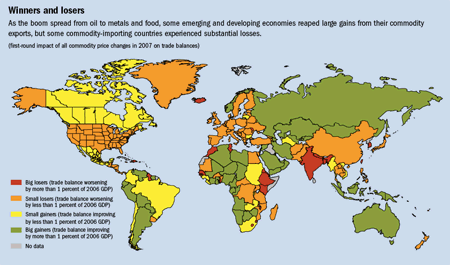
Policy implications
The current commodity price boom has raised new policy issues. From a multilateral perspective, policy efforts should focus on ensuring the efficient functioning of market forces at the global level because markets for many commodities are highly integrated. In the oil market, for example, policy priorities should ensure a timely, full pass-through of crude oil price changes to end-user prices and enhance energy conservation incentives on the demand side. This would contribute to making global oil demand more price elastic, which could reduce the extent of oil price volatility in response to demand or supply fluctuations. On the supply side, reducing obstacles and policy uncertainty for oil and metals investment could help accelerate capacity buildup. At the same time, improving market statistics could help by enabling market participants to make informed decisions.
In the markets for major food crops, policies that ensure efficient and realistic use of biofuels and discourage protectionist elements will help reduce the prices of corn and edible oil. Current policies in both the United States and the European Union would have to be adjusted substantially, given large subsidies and the preference for domestic production even if it is relatively inefficient. For example, broadly accepted estimates suggest that Brazilian ethanol derived from sugarcane is less costly to produce (in energy-equivalent terms) than either U.S. gasoline or corn-based ethanol. Also, sugarcane ethanol produces 91 percent fewer greenhouse gas emissions per kilometer traveled than does gasoline, whereas the environmental benefits of corn- and wheat-based ethanol relative to gasoline are small. Therefore, a better policy would be to allow free trade in biofuels while incorporating emissions costs into prices of all fuels. In addition, there is a legitimate role for governments of all countries to fund promising research in second-generation biofuels, given that they serve as a public good.
In addition to policies that can enhance the functioning of global commodity markets, mitigating the impact of rising food and fuel prices on poor households has become a major policy concern. Motivated by worries about food security, a number of countries have resorted to protectionist measures, which may have contributed to global market tightness. For example, in 2007, a number of countries imposed export taxes on grains and lowered tariffs on edible oils. Instead, countries should consider targeted cash transfers to poor households, or temporary subsidies on a few selected food items consumed by the poor, if the first option is not possible. Similarly, instead of granting general domestic fuel subsidies, which generate considerable fiscal cost, encourage excessive energy consumption, and tend to disproportionately benefit wealthier households, many oil-exporting countries should minimize the effect of high fuel prices on poor households through well-designed and targeted safety nets.
Publicar un comentario